Study on Hydro-Mechanical Coupling Failure and Permeability Enhancement Mechanisms for Sandstone with T-Shaped Fractures
Abstract
1. Introduction
2. Test Method
2.1. Specimen Preparation
2.2. Description of Rock Specimens
2.3. Test Plan and Process
3. Numerical Simulation Method
3.1. Model Construction and Meshing
3.2. Governing Equations
4. Results and Discussion
4.1. Mechanical Properties of Fractured Sandstone UnderHydro-Mechanical Coupling
4.1.1. Strength Properties
4.1.2. Deformation Characteristics
4.1.3. Failure Mode
4.2. Seepage Characteristics of Fractured Sandstone under the Hydro-Mechanical Coupling
4.3. Verification of Numerical Results
4.3.1. Progressive Failure Process of Fractured Sandstone
4.3.2. Evolution Mechanism of T-Shaped Fracture Sandstone Permeability
5. Conclusions
- (1)
- The crack closure, crack initiation, and damage stress ratios of the intact specimens without water pressure and the intact specimen with water pressure are not significantly different from those of all the fractured sandstone specimens, indicating that the stress ratios are hardly affected by the shapes and angles of the internal fractures of the rock. The propagation mode and deformation characteristics of T-shaped fractures are related to the flow parameters, and the weakening effect of water has less influence on the strength than prefabricated fractures. The hydro-mechanical coupling activates the prefabricated fractures and induces the expansion of T-shaped fractures to form a complex fracture network and increase the rock permeability. Tensile and shear failure modes formed by interconnected secondary fractures are the basic principles of permeability enhancement in sandstone reservoirs.
- (2)
- Experiments have shown that there is a potential connection between T-shaped fractures and the hydraulic connectivity of rock discontinuities in rocks. Hydro-mechanical coupling action causes the cracks inside the rock to initiate first at the tip of the T-shaped fractures, and then with increasing coupled stress, the cracks propagate along the two main controlling cracks of the T-shaped fractures, forming different types of cracks, such as tensile cracks, shear cracks, coplanar secondary cracks, and oblique secondary cracks, eventually merging with the out-of-plane cracks and far-field tensile cracks.
- (3)
- Under the axial load, the change in permeability of fractured rock is closely related to the development of fractures during the loading process. In the process of deformation and failure of T-shaped fracture specimens, due to the existence of cracks and the softening effect of water flow, the compaction stage to the stable crack propagation stage is shortened correspondingly. With the increase in axial pressure, the rock permeability first decreases and then increases in the pre-peak stage, and the sudden jump increases when reaching the strength failure. However, the maximum permeability occurs at the stress drop, not at the peak strength.
- (4)
- Taking the shape and angle of the specimen into consideration, the average value of the sudden jump coefficient of the permeability of the T-shaped fracture specimen is 1.34. The simulated stress-strain curves and permeability evolution of sandstone are in good agreement with the experimental results. The modified seepage coupling model can better characterize the failure mechanism and seepage evolution of rocks under hydro-mechanical coupling. The flow vector distribution can intuitively reflect the effect of damage on permeability.
Author Contributions
Funding
Institutional Review Board Statement
Informed Consent Statement
Data Availability Statement
Conflicts of Interest
References
- Gan, Q.; Elsworth, D. Analysis of fluid injection-induced fault reactivation and seismic slip in geothermal reservoirs. J. Geophys. Res. Solid Earth 2014, 119, 3340–3353. [Google Scholar] [CrossRef]
- Wang, H.L.; Xu, W.Y.; Shao, J.F. Experimental researches on hydro-mechanical properties of altered rock under confining pressures. Rock Mech. Rock Eng. 2014, 47, 485–493. [Google Scholar] [CrossRef]
- Chen, S.W.; Yang, C.H.; Wang, G.B. Evolution of thermal damage and permeability of Beishan granite. Appl. Therm. Eng. 2017, 110, 1533–1542. [Google Scholar] [CrossRef]
- Huang, N.; Liu, R.C.; Jiang, Y.J. Numerical study of the geometrical and hydraulic characteristics of 3D self-affine rough fractures during shear. J. Nat. Gas Sci. Eng. 2017, 45, 127–142. [Google Scholar] [CrossRef]
- Rutqvist, J.; Tsang, C.-F. A study of caprock hydromechanical changes associated with CO2-injection into a brine formation. Environ. Geol. 2002, 42, 296–305. [Google Scholar] [CrossRef]
- Yuan, S.C.; Harrison, J.P. A review of the state of the art in modelling progressive mechanical breakdown and associated fluid flow in intact heterogeneous rocks. Int. J. Rock Mech. Min. 2006, 43, 1001–1022. [Google Scholar] [CrossRef]
- Jiang, T.; Shao, J.F.; Xu, W.Y.; Zhou, C.B. Experimental investigation and micromechanical analysis of damage and permeability variation in brittle rocks. Int. J. Rock Mech. Min. 2010, 47, 703–713. [Google Scholar] [CrossRef]
- Wang, L.; Liu, J.-f.; Pei, J.-l.; Xu, H.-n.; Bian, Y. Mechanical and permeability characteristics of rock under hydro-mechanical coupling conditions. Environ. Earth Sci. 2015, 73, 5987–5996. [Google Scholar] [CrossRef]
- Wanniarachchi, W.A.M.; Ranjith, P.G.; Perera, M.S.A.; Rathnaweera, T.D.; Zhang, C.; Zhang, D.C. An integrated approach to simulate fracture permeability and flow characteristics using regenerated rock fracture from 3-D scanning: A numerical study. J. Nat. Gas Sci. Eng. 2018, 53, 249–262. [Google Scholar] [CrossRef]
- Liu, X.; Lu, W.; Li, M.; Zeng, N.; Li, T. The thermal effect on the physical properties and corresponding permeability evolution of the heat-treated sandstones. Geofluids 2020, 2020, 1–16. [Google Scholar] [CrossRef]
- Lopes, J.A.; Medeiros, W.E.; Oliveira, J.G.; Santana, F.L.; Araújo, R.E.; La Bruna, V.; Xavier, M.M.; Bezerra, F.H. Three-dimensional characterization of karstic dissolution zones, fracture networks, and lithostratigraphic interfaces using GPR cubes, core logs, and petrophysics: Implications for thief zones development in carbonate reservoirs. Mar. Pet. Geol. 2023, 150, 106126. [Google Scholar] [CrossRef]
- Wang, D.-B.; Zhou, F.-J.; Li, Y.-P.; Yu, B.; Martyushev, D.; Liu, X.-F.; Wang, M.; He, C.-M.; Han, D.-X.; Sun, D.-L. Numerical simulation of fracture propagation in Russia carbonate reservoirs during refracturing. Pet. Sci. 2022, 19, 2781–2795. [Google Scholar] [CrossRef]
- Medici, G.; West, L.J. Review of groundwater flow and contaminant transport modelling approaches for the Sherwood Sandstone aquifer, UK; insights from analogous successions worldwide. Q. J. Eng. Geol. Hydrogeol. 2022, 55. [Google Scholar] [CrossRef]
- He, R.; Yang, Z.; Li, X.; Li, Z.; Liu, Z.; Chen, F. A comprehensive approach for fracability evaluation in naturally fractured sandstone reservoirs based on analytical hierarchy process method. Energy Sci. Eng. 2019, 7, 529–545. [Google Scholar] [CrossRef]
- Yang, T.H.; Liu, J.; Zhu, W.C.; Elsworth, D.; Tham, L.G.; Tang, C.A. A coupled flow-stress-damage model for groundwater outbursts from an underlying aquifer into mining excavations. Int. J. Rock Mech. Min. 2007, 44, 87–97. [Google Scholar] [CrossRef]
- Mitchell, T.M.; Faulkner, D.R. Experimental measurements of permeability evolution during triaxial compression of initially intact crystalline rocks and implications for fluid flow in fault zones. J. Geophys. Res. 2008, 113. [Google Scholar] [CrossRef]
- Yang, S.-Q.; Huang, Y.-H. Effect of damage on gas seepage behavior of sandstone specimens. J. Rock Mech. Geotech. 2020, 12, 866–876. [Google Scholar] [CrossRef]
- Hou, C.; Ma, J.; Jin, X.; Ni, D. Experimental study on the permeability evolution and gas flow law of post-strength soft coal. Appl. Sci. 2020, 10, 1039. [Google Scholar] [CrossRef]
- Zhou, Y.; Zhao, D.J.; Li, B.; Wang, H.; Tang, Q.; Zhang, Z. Fatigue damage mechanism and deformation behaviour of granite under ultrahigh-frequency cyclic loading conditions. Rock Mech. Rock Eng. 2021, 54, 4723–4739. [Google Scholar] [CrossRef]
- Kou, M.M.; Liu, X.R.; Wang, Y.T. Study on rock fracture behavior under hydromechanical loading by 3-D digital reconstruction. Struct. Eng. Mech. 2020, 74, 283–296. [Google Scholar]
- Kou, M.-M.; Liu, X.-R.; Wang, Z.Q.; Nowruzpour, M. Mechanical properties, failure behaviors and permeability evolution of fissured rock-like materials under coupled hydro-mechanical unloading. Eng. Fract. Mech. 2021, 254, 107929. [Google Scholar] [CrossRef]
- Baud, P.; Zhu, W.L.; Wong, T.F. Failure mode and weakening effect of water on sandstone. J. Geophys. Res. 2000, 105, 16371–16389. [Google Scholar] [CrossRef]
- Lajtai, E.Z.; Schmidtke, R.H.; Bielus, L.P. The effect of water on the time-dependent deformation and fracture of a granite. Int. J. Rock Mech. Min. Sci. Geomech. Abstr. 1987, 24, 247–255. [Google Scholar] [CrossRef]
- Masuda, K. Effect of water on rock strength in a brittle regime. J. Struct. Geol. 2001, 23, 1653–1657. [Google Scholar] [CrossRef]
- Helland, J.; Raab, S. Experimental investigation of the differential stress on permeability of a lower Permian (Rotliegend) sandstone deformed in the brittle deformation field. Phys. Chem. Earth 2001, 26, 33–38. [Google Scholar] [CrossRef]
- Wang, J.A.; Park, H.D. Fluid permeability of sedimentary rocks in a complete stress-strain process. Eng. Geol. 2002, 63, 291–300. [Google Scholar] [CrossRef]
- Li, P.; Cai, M.F.; Gao, Y.B.; Wang, P.T.; Miao, S.J.; Wang, Y. Fracture evolution and failure behavior around an opening in brittle jointed rocks subjected to uniaxial compression. Theor. Appl. Fract. Mech. 2022, 122, 103651. [Google Scholar] [CrossRef]
- Zhu, W.; Wong, T.F. Permeability reduction in a dilating rock: Network modeling of damage and tortuosity. Geophys. Res. Lett. 1996, 23, 3099–3102. [Google Scholar] [CrossRef]
- David, C.; Menendez, B.; Zhu, W. Mechanical compaction, microstructures and permeability in sandstones. Phys. Chem. Earth 2001, 26, 45–51. [Google Scholar] [CrossRef]
- Chen, Y.F.; Hu, S.H.; Wei, K.; Hu, R. Experimental characterization and micromechanical modeling of damage-induced permeability variation in Beishan granite. Int. J. Rock Mech. Min. 2014, 71, 64–76. [Google Scholar] [CrossRef]
- Xiao, W.J.; Zhang, D.M.; Wang, X.J. Experimental study on progressive failure process and permeability characteristics of red sandstone under seepage pressure. Eng. Geol. 2020, 265, 105406. [Google Scholar] [CrossRef]
- Lin, Q.; Cao, P.; Wang, H.; Cao, R. An experimental study on cracking behavior of precracked sandstone specimens under seepage pressure. Adv. Civ. Engineering. 2018, 2018, 4068918. [Google Scholar] [CrossRef]
- Zhou, H.W.; Wang, Z.H.; Ren, W.G.; Liu, Z.L. Acoustic emission based mechanical behaviors of Beishan granite under conventional triaxial compression and hydro-mechanical coupling tests. Int. J. Rock Mech. Min. Sci. 2019, 123, 104–125. [Google Scholar] [CrossRef]
- Kou, M.; Liu, X.; Tang, S.; Wang, Y. 3-D X-ray computed tomography on failure characteristics of rock-like materials under coupled hydro-mechanical loading. Theor. Appl. Fract. Mech. 2019, 104, 102396. [Google Scholar] [CrossRef]
- Akhondzadeh, H.; Keshavarz, A.; Awan, F.U.R.; Al-Yaseri, A.Z.; Iglauer, S.; Lebedev, M. Coal fracturing through liquid nitrogen treatment: A micro-computed tomography study. APPEA J. 2020, 60, 67–76. [Google Scholar] [CrossRef]
- Akhondzadeh, H.; Keshavarz, A.; Awan, F.U.R.; Ali, M. Liquid nitrogen fracturing efficiency as a function of coal rank: A multi-scale tomographic study. J. Nat. Gas Sci. Eng. 2021, 95, 104177. [Google Scholar] [CrossRef]
- Yuan, S.C.; Harrison, J.P. Development of a hydro-mechanical local degradation approach and its application to modelling fluid flow during progressive fracturing of heterogeneous rocks. Int. J. Rock Mech. Min. 2005, 42, 961–984. [Google Scholar] [CrossRef]
- Cai, Y.Y.; Chen, X.; Yu, J.; Zhou, J. Numerical study on the evolution of mesoscopic properties and permeability in sandstone under hydro-mechanical coupling conditions involving industrial internet of things. IEEE Access 2018, 6, 11804–11815. [Google Scholar] [CrossRef]
- Chen, X.; Yu, J.; Tang, C.; Li, H.; Wang, S. Experimental and numerical investigation of permeability evolution with damage of sandstone under triaxial compression. Rock Mech. Rock Eng. 2017, 50, 1529–1549. [Google Scholar] [CrossRef]
- Tan, X.; Konietzky, H.; Frühwirt, T. Laboratory observation and numerical simulation of permeability evolution during progressive failure of brittle rocks. Int. J. Rock Mech. Min. 2014, 68, 167–176. [Google Scholar] [CrossRef]
- Biot, M.A. General Theory of Three-Dimensional Consolidation. J. Appl. Phys. 1941, 12, 155–164. [Google Scholar] [CrossRef]
- Tang, C.A.; Tham, G.; Lee, P.K.K.; Yang, T.H.; Li, L.C. Coupled analysis of flow, stress and damage (FSD) in rock failure. Int. J. Rock Mech. Min. Sci. 2002, 39, 477–489. [Google Scholar] [CrossRef]
- Li, P.; Cai, M.F.; Gao, Y.B.; Gorjian, M.; Miao, S.J.; Wang, Y. Macro/mesofracture and instability behaviors of jointed rocks containing a cavity under uniaxial compression using AE and DIC techniques. Theor. Appl. Fract. Mech. 2022, 122, 103620. [Google Scholar] [CrossRef]
- Zhao, X.G.; Cai, M.; Wang, J.; Ma, L.K. Damage stress and acoustic emission characteristics of the Beishan granite. Int. J. Rock Mech. Min. Sci. 2013, 64, 258–269. [Google Scholar] [CrossRef]
- Zhang, Y.; Wu, X.; Guo, Q.; Zhang, Z.; Cai, M.; Tian, L. Research on the Mechanical Properties and Damage Constitutive Model of Multi-Shape Fractured Sandstone under Hydro-Mechanical Coupling. Minerals 2022, 12, 436. [Google Scholar] [CrossRef]

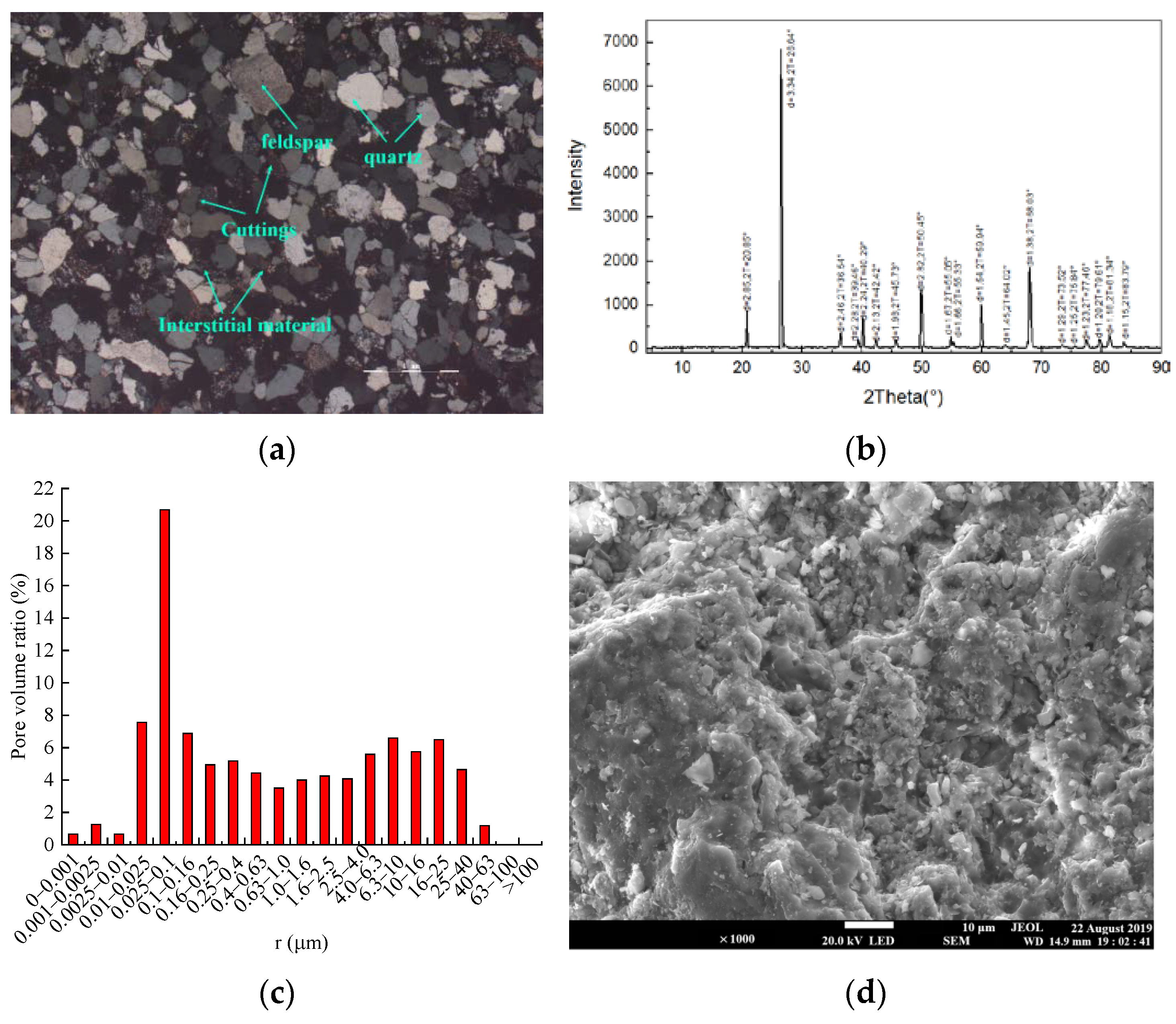

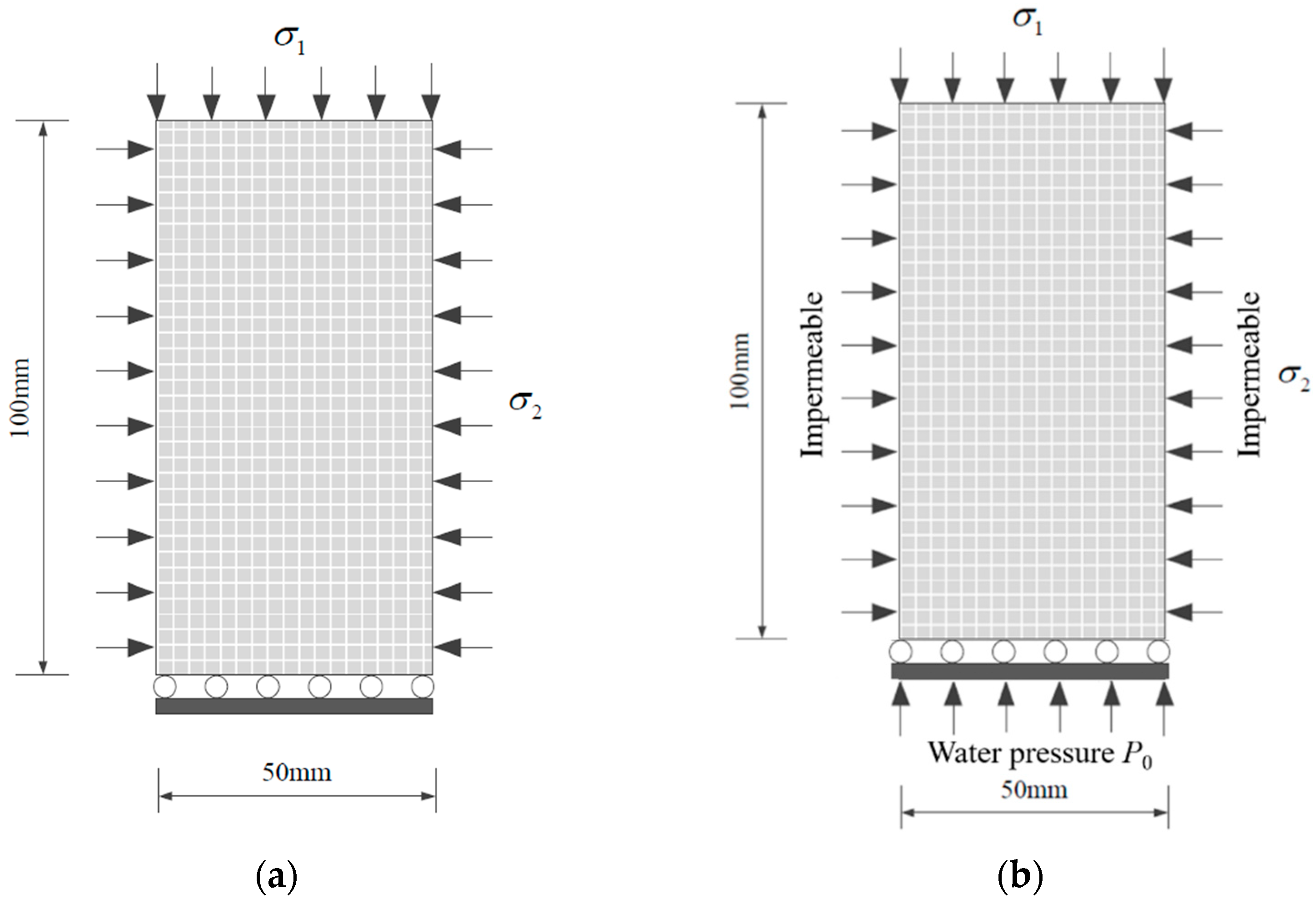


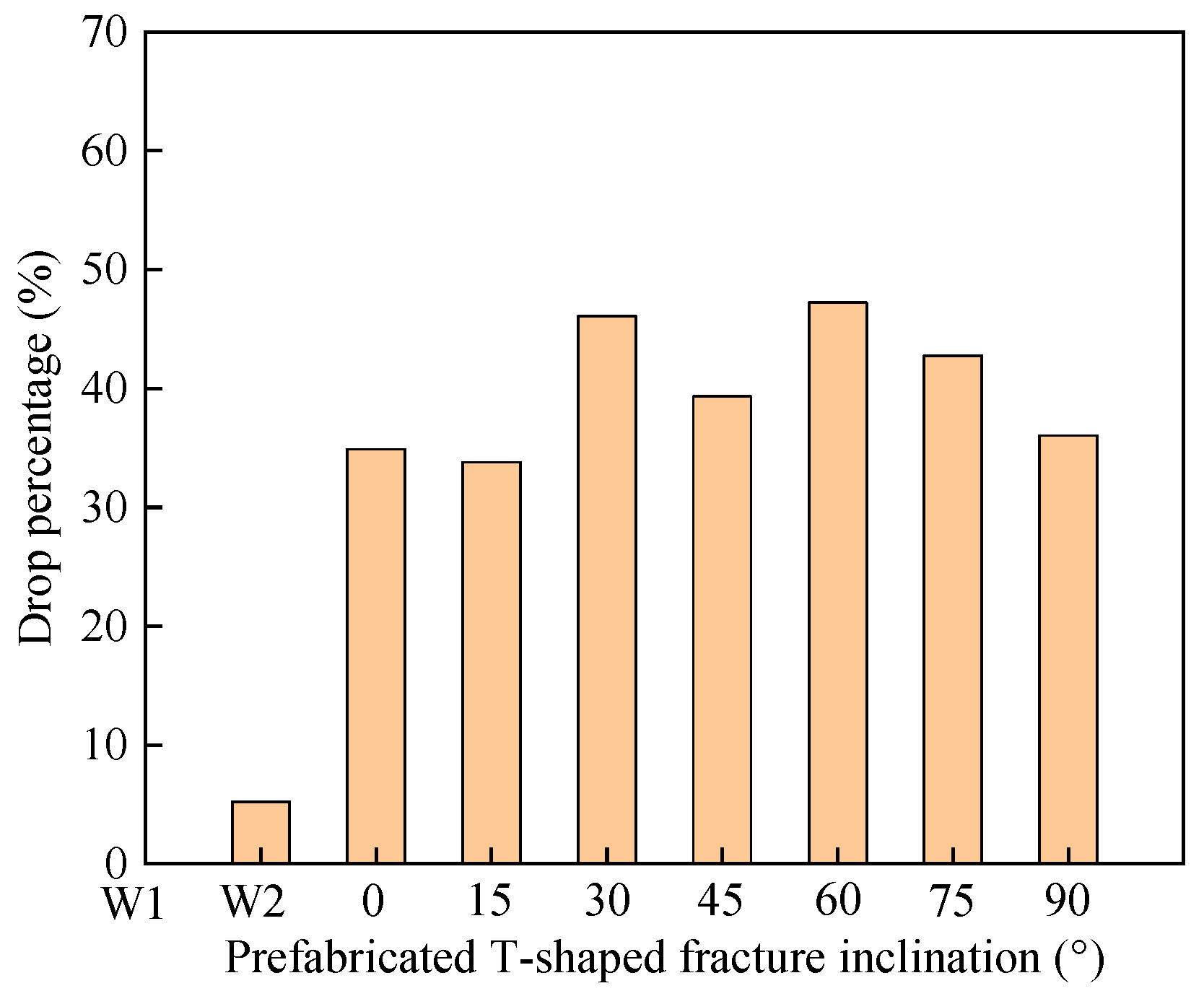

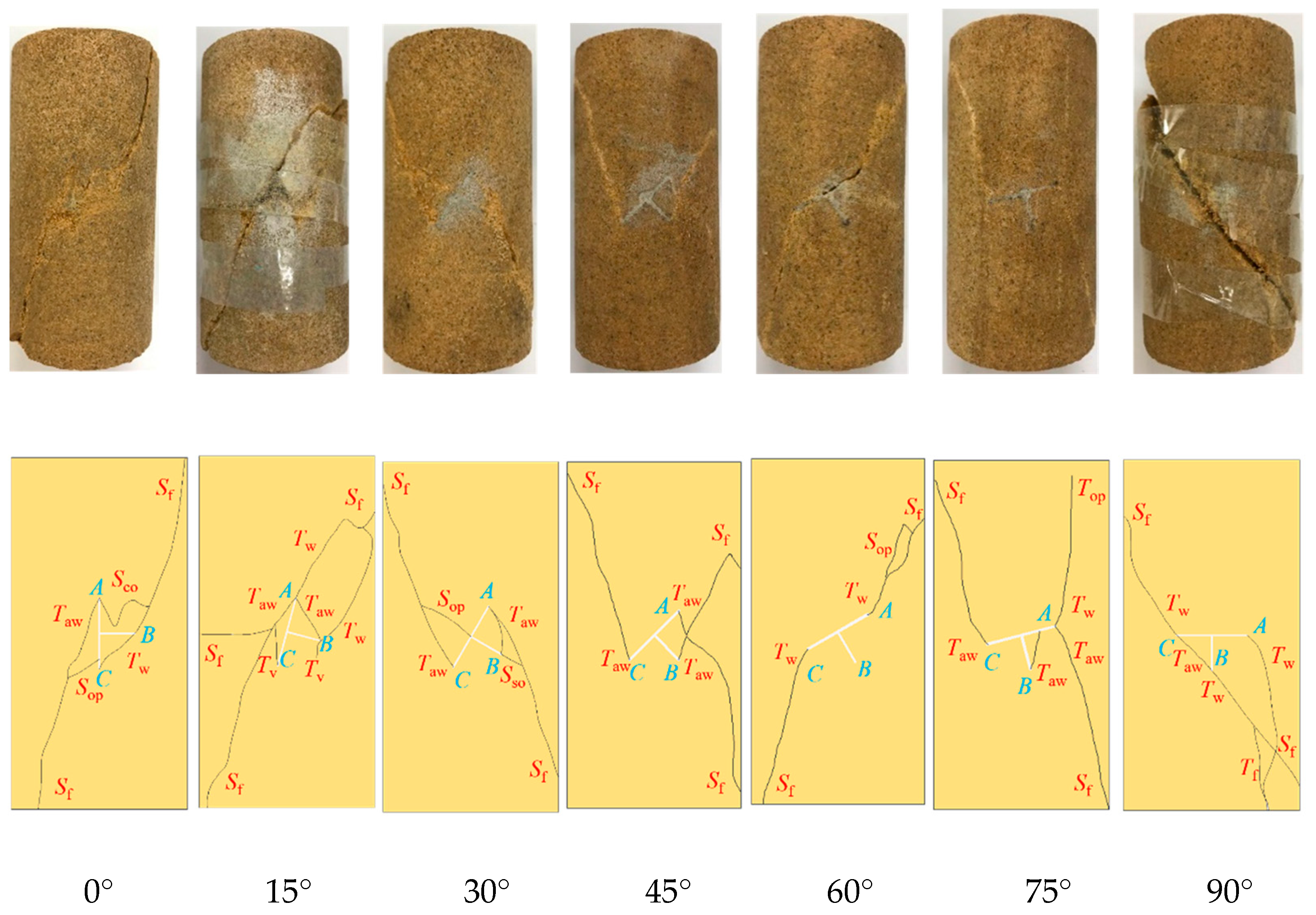

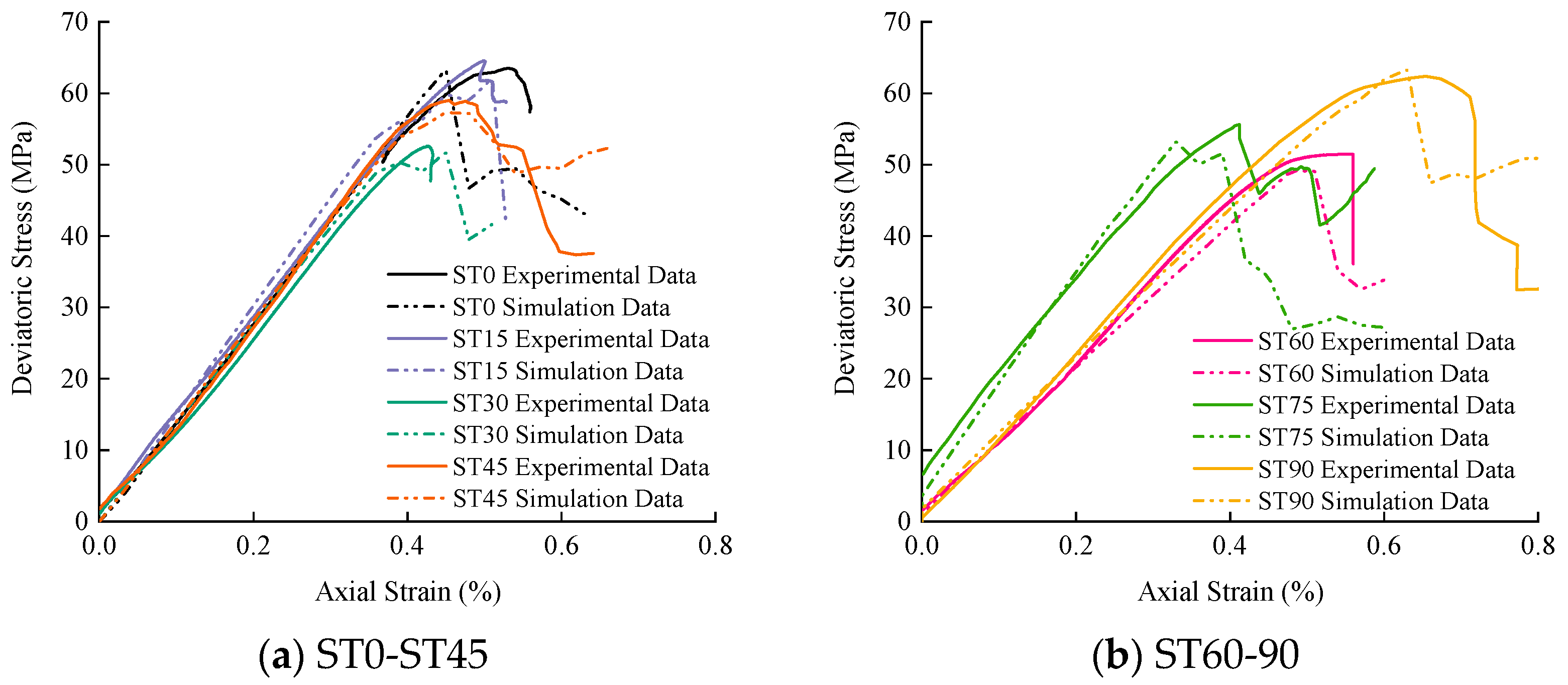
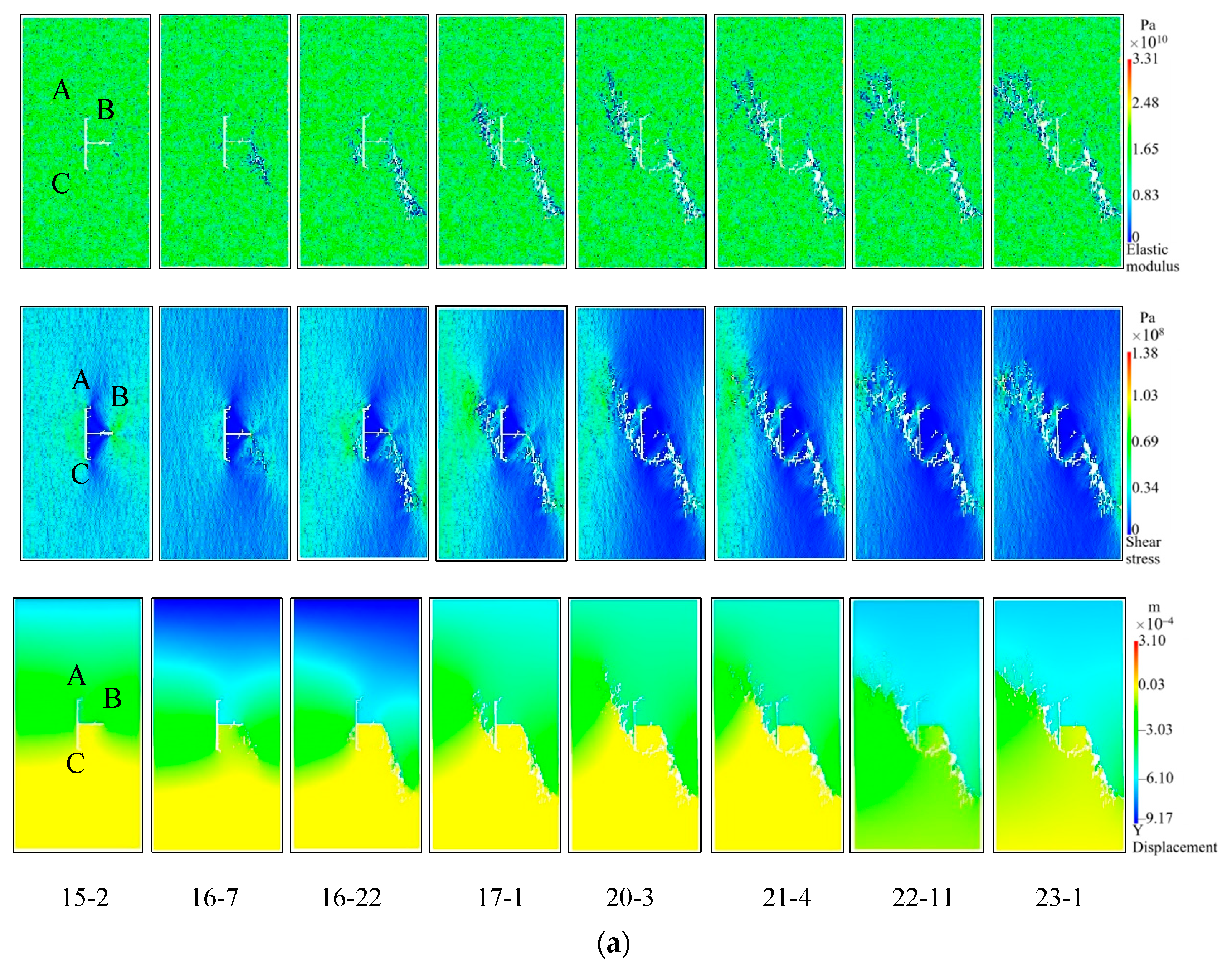
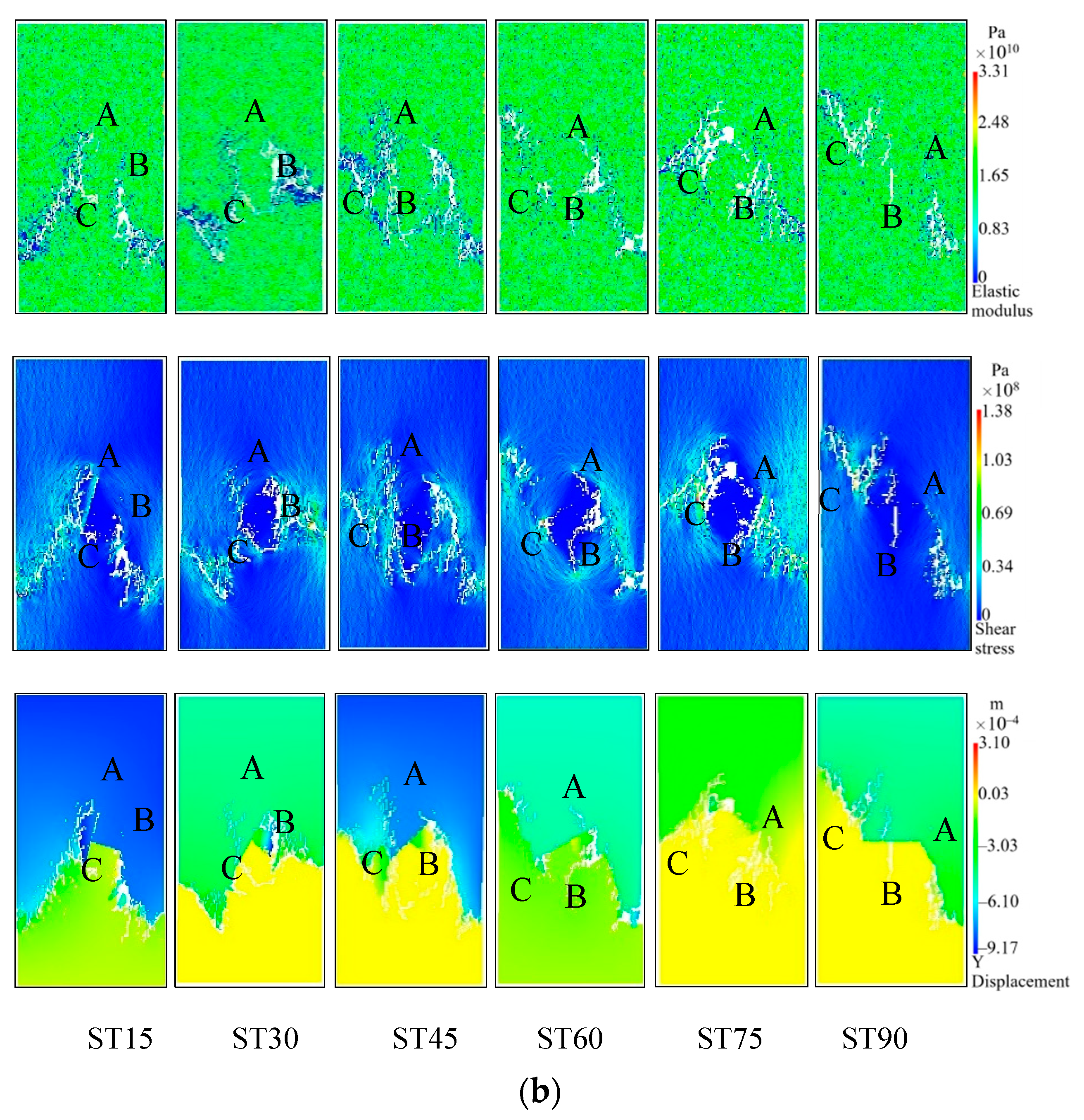

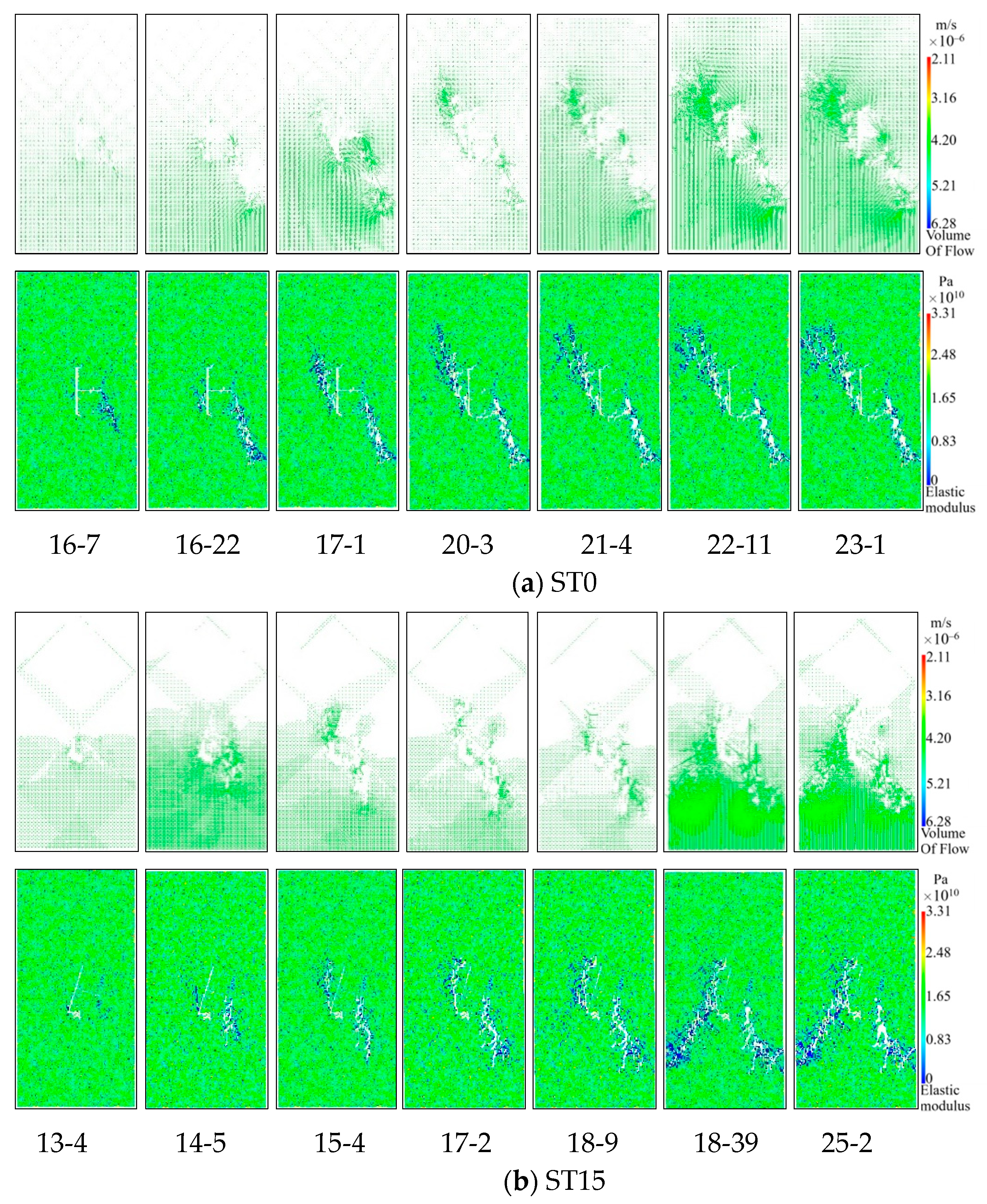
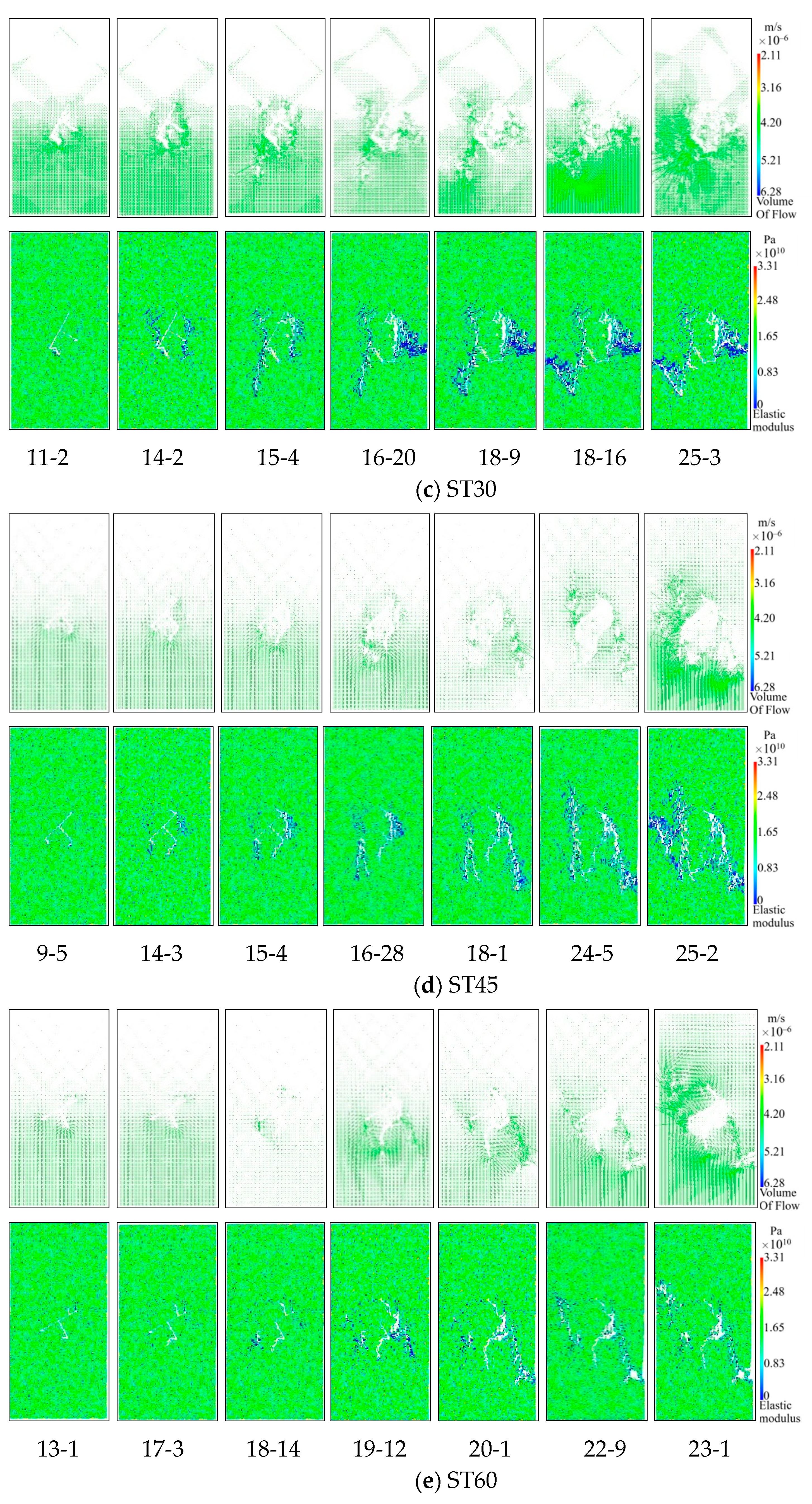

| Fracture Inclination α | Specimen No. | Confining Pressure/Mpa | Water Pressure/Mpa | |
|---|---|---|---|---|
| Intact Specimen | T-Shaped Fracture Specimen | |||
| -- | W1 | -- | 10 | -- |
| -- | W2 | -- | 10 | 3 |
| 0° | -- | ST0 | 10 | 3 |
| 15° | -- | ST15 | 10 | 3 |
| 30° | -- | ST30 | 10 | 3 |
| 45° | -- | ST45 | 10 | 3 |
| 60° | -- | ST60 | 10 | 3 |
| 75° | -- | ST75 | 10 | 3 |
| 90° | -- | ST90 | 10 | 3 |
| Fracture Inclinations/° | 0 | 15 | 30 | 45 | 60 | 75 | 90 |
|---|---|---|---|---|---|---|---|
| Elastic modulus E0/Gpa | 17.38 | 17.88 | 16.25 | 17.00 | 14.13 | 20.50 | 14.86 |
| Poisson’s ratio μ | 0.26 | 0.31 | 0.31 | 0.43 | 0.09 | 0.29 | 0.15 |
| Compressive strength σc/Mpa | 204.87 | 208.32 | 169.61 | 190.94 | 166.03 | 180.10 | 201.32 |
| Friction angle φ/° | 43 | 37 | 35 | 33 | 41 | 38 | 41 |
| Permeability coefficient k/(m/d) | 0.04 | 0.04 | 0.24 | 0.06 | 0.04 | 0.08 | 0.09 |
| Effective stress factor α | 0.80 | 0.38 | 0.29 | 0.29 | 0.41 | 0.87 | 0.33 |
| Sudden jump coefficient ξ | 1.87 | 1.22 | 1.29 | 1.22 | 1.44 | 1.18 | 1.16 |
| Coupling coefficient β | 0.0318 | 0.0850 | 0.0443 | 0.090 | 0.0251 | 0.0908 | 0.0139 |
| Specimen No. | σcc (MPa) | σci (MPa) | σcd (MPa) | σc (MPa) | σcc/σc | σci/σc | σcd/σc |
|---|---|---|---|---|---|---|---|
| W1 | 17.300 | 32.630 | 68.480 | 97.540 | 0.216 | 0.340 | 0.702 |
| W2 | 16.540 | 28.220 | 53.930 | 92.420 | 0.219 | 0.315 | 0.584 |
| ST0 | 13.560 | 20.900 | 38.970 | 63.510 | 0.249 | 0.323 | 0.614 |
| ST15 | 14.110 | 19.220 | 33.770 | 64.580 | 0.211 | 0.286 | 0.523 |
| ST30 | 8.810 | 13.930 | 27.330 | 52.580 | 0.174 | 0.259 | 0.520 |
| ST45 | 7.590 | 14.250 | 21.660 | 59.190 | 0.144 | 0.232 | 0.366 |
| ST60 | 15.070 | 20.640 | 31.100 | 51.470 | 0.290 | 0.410 | 0.604 |
| ST75 | 15.320 | 21.520 | 30.130 | 55.830 | 0.279 | 0.383 | 0.540 |
| ST90 | 19.050 | 24.000 | 43.620 | 62.410 | 0.284 | 0.368 | 0.699 |
| Specimen No. | Test Strength σc/Mpa | Simulation Strength σc0/Mpa | SD | Cov/% | Test Elastic Modulus E/Gpa | Simulated Elastic Modulus E0/Gpa | SD | Cov/% |
|---|---|---|---|---|---|---|---|---|
| ST0 | 63.51 | 63.36 | 0.11 | 0.17% | 13.90 | 15.52 | 1.15 | 7.79% |
| ST15 | 64.58 | 62.12 | 1.74 | 2.75% | 14.30 | 17.66 | 2.38 | 14.87% |
| ST30 | 52.58 | 51.69 | 0.63 | 1.21% | 13.00 | 15.47 | 1.75 | 12.27% |
| ST45 | 59.19 | 57.31 | 1.33 | 2.28% | 13.60 | 15.76 | 1.53 | 10.40% |
| ST60 | 51.47 | 49.17 | 1.63 | 3.23% | 11.30 | 10.79 | 0.36 | 3.27% |
| ST75 | 55.83 | 53.22 | 1.85 | 3.38% | 16.40 | 17.68 | 0.91 | 5.31% |
| ST90 | 62.41 | 63.34 | 0.66 | 1.05% | 11.89 | 11.87 | 0.01 | 0.12% |
| Specimen No. | Minimum Permeability/×10−16 m2 | SD | Cov/% | Maximum Permeability/×10−16 m2 | SD | Cov/% | ||
|---|---|---|---|---|---|---|---|---|
| Test | Simulation | Test | Simulation | |||||
| W2 | 2.18 | 1.85 | 0.23 | 11.58% | 6.80 | 6.87 | 0.05 | 0.72% |
| ST0 | 5.32 | 5.41 | 0.06 | 1.19% | 9.93 | 10.21 | 0.20 | 1.97% |
| ST15 | 6.63 | 6.21 | 0.30 | 4.63% | 8.12 | 8.46 | 0.24 | 2.90% |
| ST30 | 36.39 | 6.91 | 20.85 | 96.28% | 46.97 | 9.75 | 26.32 | 92.80% |
| ST45 | 10.19 | 9.75 | 0.31 | 3.12% | 12.43 | 12.56 | 0.09 | 0.74% |
| ST60 | 6.43 | 6.36 | 0.05 | 0.77% | 9.24 | 9.72 | 0.34 | 3.58% |
| ST75 | 13.38 | 13.14 | 0.17 | 1.28% | 15.84 | 16.76 | 0.65 | 3.99% |
| ST90 | 13.25 | 13.50 | 0.18 | 1.32% | 15.41 | 16.05 | 0.45 | 2.88% |
Disclaimer/Publisher’s Note: The statements, opinions and data contained in all publications are solely those of the individual author(s) and contributor(s) and not of MDPI and/or the editor(s). MDPI and/or the editor(s) disclaim responsibility for any injury to people or property resulting from any ideas, methods, instructions or products referred to in the content. |
© 2023 by the authors. Licensee MDPI, Basel, Switzerland. This article is an open access article distributed under the terms and conditions of the Creative Commons Attribution (CC BY) license (https://creativecommons.org/licenses/by/4.0/).
Share and Cite
Zhang, Y.; Bi, K.; Pan, J.; Xi, X.; Zhang, D.; Miao, S.; Cai, M. Study on Hydro-Mechanical Coupling Failure and Permeability Enhancement Mechanisms for Sandstone with T-Shaped Fractures. Materials 2023, 16, 3118. https://doi.org/10.3390/ma16083118
Zhang Y, Bi K, Pan J, Xi X, Zhang D, Miao S, Cai M. Study on Hydro-Mechanical Coupling Failure and Permeability Enhancement Mechanisms for Sandstone with T-Shaped Fractures. Materials. 2023; 16(8):3118. https://doi.org/10.3390/ma16083118
Chicago/Turabian StyleZhang, Ying, Kun Bi, Jiliang Pan, Xun Xi, Dongsheng Zhang, Shengjun Miao, and Meifeng Cai. 2023. "Study on Hydro-Mechanical Coupling Failure and Permeability Enhancement Mechanisms for Sandstone with T-Shaped Fractures" Materials 16, no. 8: 3118. https://doi.org/10.3390/ma16083118
APA StyleZhang, Y., Bi, K., Pan, J., Xi, X., Zhang, D., Miao, S., & Cai, M. (2023). Study on Hydro-Mechanical Coupling Failure and Permeability Enhancement Mechanisms for Sandstone with T-Shaped Fractures. Materials, 16(8), 3118. https://doi.org/10.3390/ma16083118










